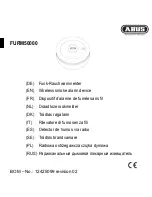
e1276e
9
Siemens Building T
echnologies
Cerberus Division
09.2000
3.6
Description of block diagram
The transmitter
1
transmits the light pulses to the reflector
2
. This transmits the light
pulses back to the receiver
3
. The light pulses are proportional to the signal current,
which is amplified in the preamplifier
4
and fed to the customer-specific integrated circuit
(ASIC)
5
. The microprocessor (
µ
P)
6
synchronizes the receiver pulses with the trans-
mitter pulses so that no external pulse is evaluated.
The sensor-specific functions are contained in the ASIC. It is used to filter signals, pro-
cess signals using fuzzy algorithms, amplify signals and for the entire sequence control
which is synchronized with the
µ
P.
The
µ
P communicates with the control unit via the line interface
7
via terminals
8
and
the two-wire bus line. The detector receives commands which activate the type of opera-
ting mode, diagnostic stages etc. via the data interface which is integrated in the line inter-
face. The detector transmits response signals, the results of diagnostic polling and status
signals back to the control unit.
With the help of the isolation function, sections which malfunction are “isolated”, so that in
the event of a short circuit, the entire bus line does not break down. Upon short circuit, two
“electronic switches” (FET) open automatically and isolate the line in the area where the
malfunction has occurred until the short circuit has been eliminated.
The internal response indicator (AI)
9
and the external response indicator
10
provide in-
dication of alarm and are activated by the control unit.
The 6 DIP switches
11
allow parameterization of the detector (see section 6.1).
The REED contact
12
serves to initialize the detector during commissioning (see section
6.4).
A detector heating device, which prevents condensation of the lenses, can be connected
to detector heating terminal
13
.
The DZL1191 adjustment device can be connected via connector
14
. The purpose and
function of the adjustment device is explained in section 6.3 (electronic alignment)
11
12
9
1
13
4
3
8
10
1
2
3
4
Transmitter
2
Receiver
Reflector
5
6
7
ASIC
µ
P
Pream-
plifier
Line
interface
4
5
6
+
_
YX
W
V
+
_
ZM
B
–
+
–
+
24V
–
+
Reed
internal AI
external AI
DIP switches
Adjustment
14
Detector heating
Test point for production
Reserve
contact
device
device
Fig. 10 Block diagram














































